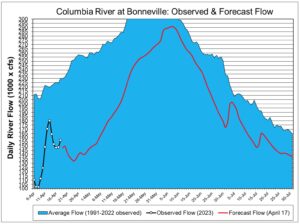Kyle Dittmer, CRITFC Hydrologist-Meteorologist
Rising rivers due to snowmelt is one of many cues that the Creator tells us that spring is here. The normal pattern of rising spring river levels is also a cue to salmon smolts to move downriver as fast as possible which helps ensure a safer passage route out to the ocean.
Current snowlines are at 1,500 feet. The snowpacks in the Oregon-Washington Cascades and southern Idaho did improve in the last six weeks. The mountain snowpacks are near their peak of the season (see snowpack map). We’re waiting for temperatures to warm up to start the snowmelt process.

Columbia Basin snowpack map. Chart data provided by NOAA/National Weather Service/Northwest River Forecast Center.
The latest NOAA/National Weather Service forecast suggests that rivers will start to rise in early May and peak in early June. Tribal fishers need to be aware of the danger of fast-moving water during these seasonal peaks and take appropriate safety precautions.
This winter marked the third La Niña event in a row, which tends to deliver cold, wet winters to the Pacific Northwest. This triple La Niña combined with climate destabilization due to accelerating climate change likely contributed to this winter’s increase in atmospheric river events.
Back in 2011, researchers estimated that the number of atmospheric river events could increase by about 30 percent by the year 2100, however this year saw a 50 percent increase. The West Coast has had 26 atmospheric river events already this season, delivering record snowfalls in California and Nevada’s Sierra Nevada Mountains (713 inches at one station) and Utah’s Wasatch Mountains (748 inches) as well as high amounts of valley rain and mountain snow in the Columbia Basin throughout Oregon, Washington, and Idaho. The western US normally sees around 10 to 15 atmospheric rivers per winter, and almost always only from November to February.
Multiple climate models predict both this increase in number and move to an earlier start and later end of the storm seasons into the future. We can also expect the total rainfall out of each atmospheric river to increase going forward because warmer air can physically hold more water vapor which becomes rainfall.


